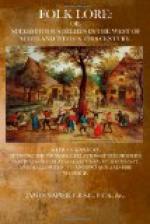Another danger from which children required to be shielded was the baneful influence of the evil eye. Malicious people were believed to possess the power of doing harm by merely looking upon those whom they wished to injure. This belief is very ancient. From Professor Conington’s Satires of A. Persius Flaccus, I extract the following notice of it:—“Look here—a grandmother or a superstitious aunt has taken baby from his cradle, and is charming his forehead and his slavering lips against mischief by the joint action of her middle finger and her purifying spittle; for she knows right well how to check the evil eye. Then she dandles him in her arms, and packs off the pinched little hope of the family, so far as wishing can do it, to the domains of Licinus, or the palace of Croesus. ’May he be a catch for my lord and lady’s daughter! May the pretty ladies scramble for him! May the ground he walks on turn to a rose-bed.’ But I will never trust a nurse to pray for me or mine; good Jupiter, be sure to refuse her, though she may have put on white for the occasion.”
The Romans used to hang red coral round the necks of their children to save them from falling-sickness, sorcery, charms, and poison. In this country coral beads were hung round the necks of babies, and are still used in country districts to protect them from an evil eye. Coral bells are used at present. The practice was originated by the Roman Catholics to frighten away evil spirits.
I have quite a vivid remembrance of being myself believed to be the unhappy victim of an evil eye. I had taken what was called a dwining, which baffled all ordinary experience; and, therefore, it was surmised that I had got “a blink of an ill e’e.” To remove this evil influence, I was subjected to the following operation, which was prescribed and superintended by a neighbour “skilly” in such matters:—A sixpence was borrowed from a neighbour, a good fire was kept burning in the grate, the door was locked, and I was placed upon a chair in front of the fire. The operator, an old woman, took a tablespoon and filled it with water. With the sixpence she then lifted as much salt as it could carry, and both were put into the water in the spoon. The water was then stirred with the forefinger till the salt was dissolved. Then the soles of my feet and the palms of my hands were bathed with this solution thrice, and after these bathings I was made to taste the solution three times. The operator then drew her wet forefinger across my brow,—called scoring aboon the breath. The remaining contents of the spoon she then cast right over the fire, into the hinder part of the fire, saying as she did so, “Guid preserve frae a’ skaith.” These were the first words permitted to be spoken during the operation. I was then put in bed, and, in attestation of the efficacy of the charm, recovered. To my knowledge this operation has been performed within these 40 years, and probably in many outlying




